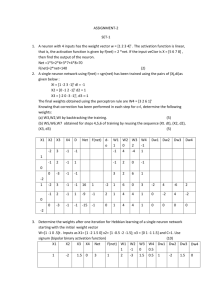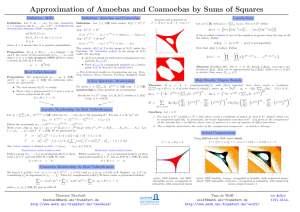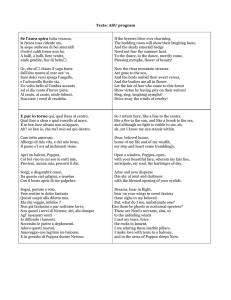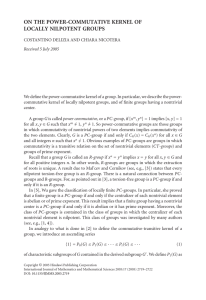Quiz 2 Practice Problems
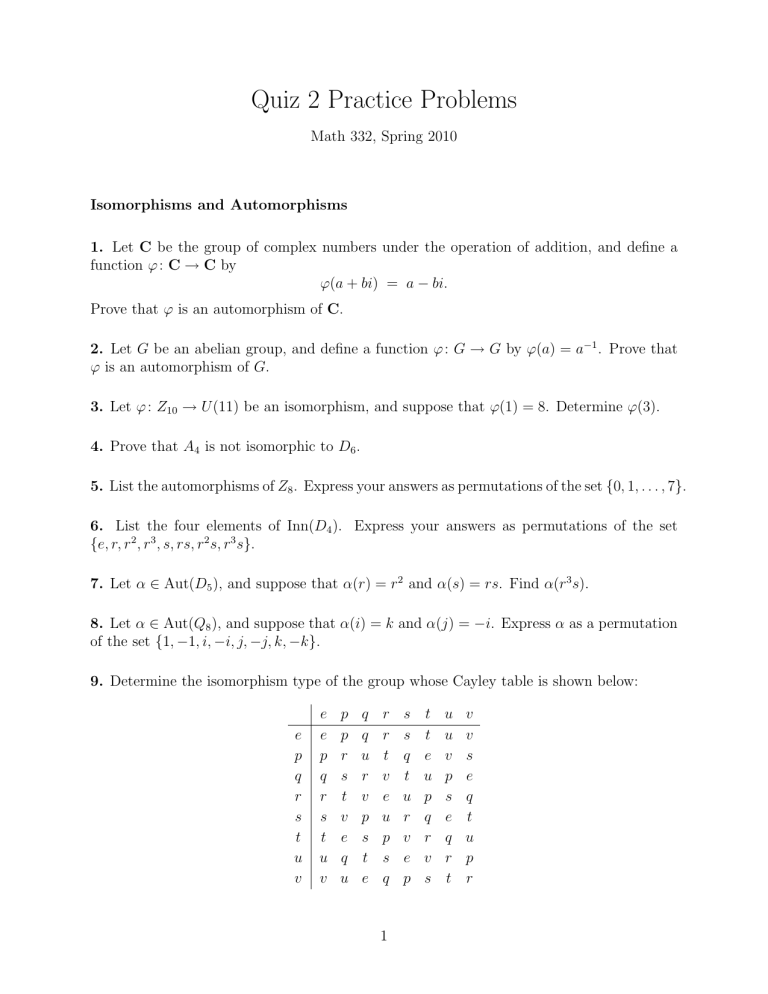
Quiz 2 Practice Problems
Math 332, Spring 2010
Isomorphisms and Automorphisms
1.
Let C be the group of complex numbers under the operation of addition, and define a function ϕ : C → C by ϕ ( a + bi ) = a − bi.
Prove that ϕ is an automorphism of C .
2.
Let G be an abelian group, and define a function ϕ : G → G by ϕ ( a ) = a
− 1
. Prove that ϕ is an automorphism of G .
3.
Let ϕ : Z
10
→ U (11) be an isomorphism, and suppose that ϕ (1) = 8. Determine ϕ (3).
4.
Prove that A
4 is not isomorphic to D
6
.
5.
List the automorphisms of Z
8
. Express your answers as permutations of the set { 0 , 1 , . . . , 7 } .
6.
List the four elements of Inn( D
4
). Express your answers as permutations of the set
{ e, r, r 2 , r 3 , s, rs, r 2 s, r 3 s } .
7.
Let α ∈ Aut( D
5
), and suppose that α ( r ) = r
2 and α ( s ) = rs . Find α ( r
3 s ).
8.
Let α ∈ Aut( Q
8
), and suppose that α ( i ) = k and α ( j ) = − i . Express α as a permutation of the set { 1 , − 1 , i, − i, j, − j, k, − k } .
9.
Determine the isomorphism type of the group whose Cayley table is shown below: e p q r s t u v e e p q r s t u v p p r u t q e v s q q s r v t u p e r r t v e u p s q s s v p u r q e t t t e s p v r q u u u q t s e v r p v v u e q p s t r
1
Direct Products
10.
Let G be a group, and define a function ϕ : G × G × G → G × G × G by ϕ ( a, b, c ) = ( b, c, a ) .
Prove that ϕ is an automorphism of G × G × G .
11.
Let G be a group, and let ∆ be the following subset of G × G :
∆ = { ( g, g ) : g ∈ G } .
Prove that ∆ is a subgroup of G × G .
12.
Let α be an automorphism of Z
5
Determine α (2 , 0).
× Z
5 satisfying α (1 , 4) = (2 , 1) and α (0 , 1) = (1 , 0).
13.
Find an element of order 12 in Q
8
× S
3
.
14.
Find an element of order 6 in A
4
× Z
9
.
15.
Determine the number of elements of order 6 in D
4
× S
3
.
16.
Determine the number of elements of order 9 in Z
9
× Z
9
.
17.
Determine the isomorphism type of each of the following groups. In each case, express your answer as a direct product of cyclic groups:
(a) U (77) (b) U (165) (c) U (135) (d) U (72)
18.
Determine the isomorphism type of Aut( Z
45
). Express your answer as a direct product of cyclic groups.
19.
Determine the isomorphism type of Aut U (25) . Express your answer as a direct product of cyclic groups.
20.
What is the largest order of any element of U (900)?
21.
List four non-isomorphic groups of order 12.
22.
List four non-isomorphic groups of order 30.
2
Cosets and Lagrange’s Theorem
23.
Let H = { e, (1 2)(3 4) , (1 3)(2 4) , (1 4)(2 3) } .
(a) Find the left cosets of H in A
4
.
(b) How many left cosets does H have in S
4
?
24.
Determine the left cosets of the subgroup { 1 , 11 } in U (30).
25.
Determine the left cosets of the subgroup { (0 , 0 , 0) , (1 , 1 , 1) } in Z
2
× Z
2
× Z
2
.
26.
Let G be a group of order pq , where p and q are prime. Prove that every proper subgroup of G is cyclic.
27.
Compute the following:
(a) 5 15 mod 7 (b) 7 13 mod 11 (c) 8 50 mod 35
28.
Suppose that a group contains elements of orders 1 through 10. What is the minimum possible order of the group?
29.
Let G be the permutation group with the following eight elements: e, (1 2)(3 4) , (1 3)(2 4) , (1 4)(2 3) , (1 3)(5 6) , (2 4)(5 6) , (1 2 3 4)(5 6) , (1 4 3 2)(5 6)
(a) Find the stabilizer of 1 in G .
(b) Find the orbit of 1 under G .
(c) Find the stabilizer in 5 in G .
(d) Find the orbit of 5 under G .
30.
Let G be a permutation group of order 60, and suppose that the orbit of 1 under G is
{ 1 , 3 , 4 , 6 } . Determine the order of the stabilizer of 1 in G .
3
Answers
1.
Clearly ϕ is a bijection. Furthermore, if a + bi, c + di ∈ C , then ϕ ( a + bi ) + ( c + di ) = ϕ ( a + c ) + ( b + d ) i = ( a + c ) − ( b + d ) i
= ( a − bi ) + ( c − di ) = ϕ ( a + bi ) + ϕ ( c + di ), which proves that ϕ is an isomorphism.
2.
Clearly ϕ is a bijection. Furthermore, if a, b ∈ G , then ϕ ( ab ) = ( ab )
− 1
= b
− 1 a
− 1
= a
− 1 b
− 1
= ϕ ( a ) ϕ ( b ), which proves that ϕ is an isomorphism.
3.
ϕ (3) = 8
3 mod 11 = 6.
4.
D
6 has an element of order 6, but A
4 does not.
5.
e, (1 3)(2 6)(5 7) , (1 5)(3 7) , (1 7)(2 6)(3 5)
6.
e, ( s r
2 s )( rs r
3 s ) , ( r r
3
)( rs r
3 s ) , ( r r
3
)( s r
2 s )
7.
α ( r
3 s ) = α ( r )
3
α ( s ) = ( r
2
)
3
( rs ) = r
2 s .
8.
( i k − j )( − i − k j )
9.
Q
8
10.
Clearly ϕ is a bijection. Furthermore, if ( a, b, c ) , ( a
0
, b
0
, c
0
) ∈ G × G × G , then ϕ ( a, b, c )( a
0
, b
0
, c
0
) = ϕ ( aa
0
, bb
0
, cc
0
) = ( bb
0
, cc
0
, aa
0
)
= ( b, c, a )( b
0
, c
0
, a
0
) = ϕ ( a, b, c ) ϕ ( a
0
, b
0
, c
0
), which proves that ϕ is an isomorphism.
11.
We shall use the one-step subgroup test. Clearly ∆ is a nonempty subset of G × G .
Furthermore, if ( g, g ) , ( h, h ) ∈ ∆, then
( g, g )( h, h )
− 1
= ( g, g )( h
− 1
, h
− 1
) = ( gh
− 1
, gh
− 1
) ∈ ∆ which proves that ∆ is a subgroup of G × G .
12.
Since α (1 , 0) = α (1 , 4) + α (0 , 1) = (2 , 1) + (1 , 0) = (3 , 1), we conclude that α (2 , 0) =
α (1 , 0) + α (1 , 0) = (3 , 1) + (3 , 1) = (1 , 2).
4
13.
i, (1 2 3)
14.
(1 2)(3 4) , 3
15.
D
4 has 5 elements of order 2, and elements of order 6.
S
3 has 2 elements of order 3, so D
4
× S
3 has 10
16.
Each Z
9 has 6 elements of order 9, and 3 elements of order 1 or 3. Therefore has 6 × 6 + 3 × 6 + 6 × 3 = 72 elements of order 9.
Z
9
× Z
9
17.
(a) Z
6
× Z
10
(b) Z
2
× Z
4
× Z
10
(c) Z
4
× Z
18
(d) Z
6
× Z
2
× Z
2
18.
Aut( Z
45
) ≈ U (45) ≈ U (5) × U (9) ≈ Z
4
× Z
6
19.
Aut U (25) ≈ Aut( Z
20
) ≈ U (20) ≈ U (4) × U (5) ≈ Z
2
× Z
4
20.
Since U (900) ≈ U (4) × U (9) × U (25) ≈ Z
2 lcm(2 , 6 , 20) = 60.
× Z
6
× Z
20
, the largest possible order is
21.
Z
12
, Z
2
× Z
6
, D
6
, A
4
22.
Z
30
, D
15
, D
3
× Z
5
, D
5
× Z
3
(Note that the last three groups all have a different number of elements of order 2, and are therefore not isomorphic.)
23.
(a) { e, (1 2)(3 4) , (1 3)(2 4) , (1 4)(2 3) } , { (1 2 3) , (1 3 4) , (2 4 3) , (1 4 2) } ,
{ (1 2 4) , (1 4 3) , (1 3 2) , (2 3 4) } (b) 6
24.
{ 1 , 11 } , { 7 17 } , { 13 , 23 } , { 19 , 29 }
25.
{ (0 , 0 , 0) , (1 , 1 , 1) } , { (1 , 0 , 0) , (0 , 1 , 1) } , { (0 , 1 , 0) , (1 , 0 , 1) } , { (0 , 0 , 1) , (1 , 1 , 0) }
26.
Let H be a proper subgroup of G . By Lagrange’s theorem | H | must be a factor of pq , so | H | ∈ { 1 , p, q, pq } . Since H is a proper subgroup, we know that | H | 6 = pq . Therefore H either has prime order or is trivial, which in either case implies that H is cyclic.
27.
(a) 6 (b) 2 (c) 29
28.
lcm(1 , 2 , 3 , 4 , 5 , 6 , 7 , 8 , 9 , 10) = 2 3 × 3 2 × 5 × 7 = 2520
29.
(a) { e, (2 4)(5 6) } (b) { 1 , 2 , 3 , 4 } (c) { e, (1 2)(3 4) , (1 3)(2 4) , (1 4)(2 3) } (d) { 5 , 6 }
30.
60 / 4 = 15.
5
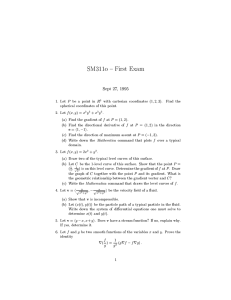


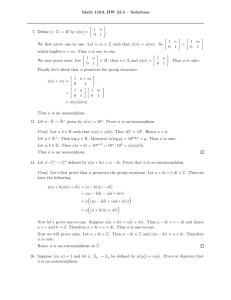
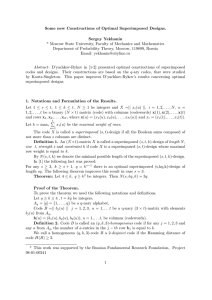
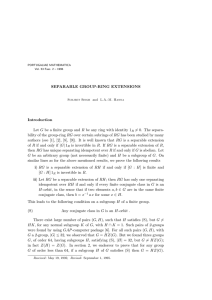

![5.5 The Haar basis is Unconditional in L [0, 1], 1 < 1](http://s2.studylib.net/store/data/010396305_1-450d5558097f626a0645448301e2bb4e-300x300.png)
